MENLO PARK, CALIF. (November 8, 2023) –
In the early morning of August 30th, 2023, Hurricane Idalia made landfall in the Big Bend Region of Florida. As the storm migrated northeast, it left behind a trail of flooding and destruction. While a full evaluation of the extent of Idalia’s destruction is still underway, early appraisals measure to $2-5 billion for insured damages alone, not accounting for the extensive uninsured damages.
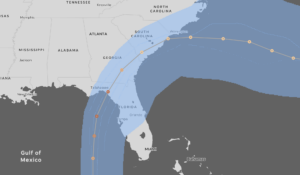
Two months post-storm, numerous affected communities are still continuing their rebuilding efforts. It is imperative for businesses to forecast potential losses from extreme weather events such as Hurricane Idalia. This foresight allows them to either reduce these losses or manage them effectively.
One Concern facilitates this forward-thinking approach through sophisticated resilience analytics. One Concern Domino AI provides insights beyond property damage – it quantifies property downtime resulting from the collapse of lifelines and infrastructure essential for business operations.
Hurricane Idalia caused widespread power damage due to high wind speeds across the northeastern region of Florida. One Concern’s digital twin technology was evaluated on the power downtime in 10 of the most affected Florida counties. One Concern’s power model predicted power downtime at the building-level, and the results were aggregated to the county-level for validation with ground-truth data. As illustrated below (Fig. 1), our model accurately estimated the peak number of power outages in each county during the event, with Columbia and Taylor County being the most and least affected, respectively. Our simulated forecasts displayed a median error of -2.9% (-5.7% to -0.5% range), accurately gauging the peak number of customers without power and the duration of the outage within a few hours.
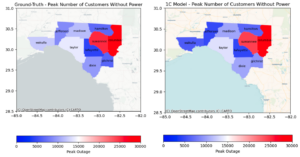
As illustrated in Table 1 below, the observed peak number of customers without power is within a narrow margin of our model prediction range. Additionally, for CAIDI* and SAIDI*, the two metrics used to demonstrate recovery speed, the ground truth data is within our model simulated range.
Table 1 – Hurricane Idalia: power loss simulation vs ground truth
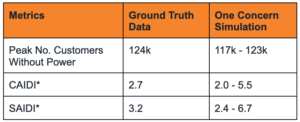
*CAIDI: Customer Average Interruption Duration Index is the average total downtime (reported in days) per interrupted customer during this event.
*SAIDI: System Average Interruption Duration Index is the average total downtime (reported in days) per total customer.
Analogous to the previous findings, our model prediction closely replicates the recovery curve from the storm. The recovery curves presented in Figure 2 demonstrate that the ground truth data aligns well within the 5%-50% quantile of our prediction in the days after the storm made landfall.
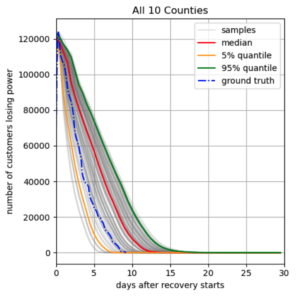
As previously stated, our resilience analytics enabled modeling of the storm’s impact at the building-level. We then aggregated the building-level results to the county-level to accommodate the resolution of the ground-truth data, which are summarized in Table 2 below.
Table 2 – One Concern prediction validated by ground truth data
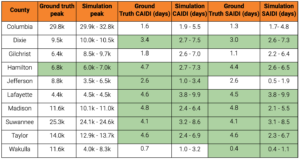
One Concern’s estimates, including SAIDI, CAIDI, and the peak number of power outages, were in close alignment with the ground truth data across almost all parameters. Across the ten counties analyzed, real-world observations fell well within the model’s predictive range. Any metrics not matching the model’s forecast were off by a narrow margin – up to 3,000 customers for peak outages, and one day in terms of SAIDI/CAIDI.
Our model’s accuracy stems from robust power recovery simulation, detailed digital twin, and extensive parameter training and calibration with past event data. Even in the face of a severe storm like Hurricane Idalia, our technology is adept at gauging the repercussions, thus equipping businesses with the knowledge to gauge and prepare for long-term power outage risks through our One Concern Domino AI platform.
Enhanced insights and robust data equip (re)insurers, asset managers, and financial institutions to better respond to and quantify the complete spectrum of climate-related physical risks, including both direct impacts and those related to dependencies and infrastructure.
